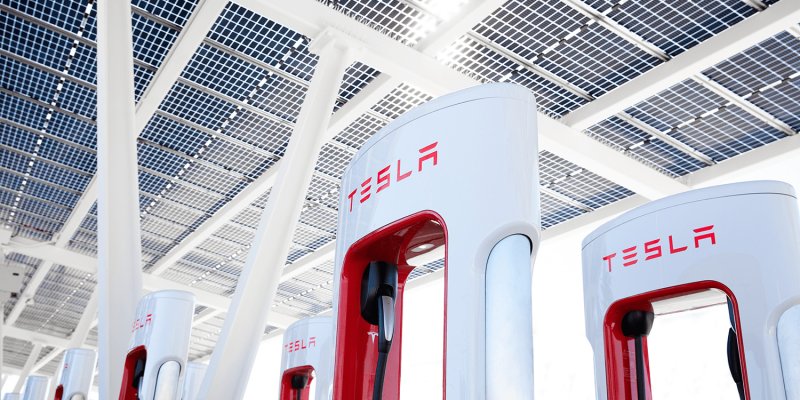Tesla Added 27 More V3 Supercharger Stations to its Charging Network in China Last Month
【Summary】Electric automaker Tesla continues to build out its charging network in China at a rapid pace. The company added 27 new Supercharger stations last month comprising 147 charging piles, local media outlet CnEVPost reported on Friday. The new Tesla Superchargers are located in 20 Chinese cities, including Hangzhou, Guangzhou, Wuhan and Shanghai. All of the new chargers are Tesla's more powerful V3 Superchargers.

Electric automaker Tesla continues to build out its charging network in China at a rapid pace. The company added 27 new Supercharger stations last month comprising 147 charging piles, local media outlet CnEVPost reported on Friday.
The new Tesla Superchargers are located in 20 Chinese cities, including Hangzhou, Guangzhou, Wuhan and Shanghai. All of the new chargers are more powerful V3 chargers, according to CnEVPost.
To date, Tesla has installed more than 1,100 Supercharger stations in the Chinese mainland, including more than 8,500 individual charging piles. The company also has over 700 destination charging stations offering more than 1,800 charging piles, with more on the way.
Tesla is also adding Supercharger stations in Beijing, Tianjin, Hangzhou, Guangzhou and Chongqing, CnEVPost reported. Some of these new stations will be operational this month.
The newly-launched V3 Superchargers were built at Tesla's supercharger manufacturing factory in Shanghai, which started production on Feb 3, 2021.
The 54,000 square foot factory currently has an annual capacity to build 10,000 Superchargers. Most being built in China are the more powerful V3 chargers. Tesla invested 420 million yuan (US$65.2 million) in the new facility.
Before the Shanghai factory was built, all of Tesla's superchargers deployed in China were imported from the U.S. The chargers were first built at Tesla's Fremont, California factory where it builds all of the vehicles sold in the U.S. Tesla has since moved Supercharger production to its Gigafactory 2 in Buffalo, New York, where it also manufactures solar roof tiles for Tesla's solar business.
Tesla unveiled its next-generation, V3 Superchargers in March 2019. The company said the more powerful Superchargers can add 175 miles of range to a Model 3 sedan in about 15 minutes.
Tesla's V3 Superchargers can also charge more vehicles at the same time. The company said the V3 Superchargers will ultimately cut the amount of time customers spend charging their vehicles by an average of 50%, based on fleet data collected by Tesla.
The V3 Superchargers support a peak charge rate of up to 250kW, which is more than double the output of the Tesla's bolder V2 Superchargers, which delivers a peak charging rate of 120kW.
Tesla said it completely redesigned the electrical architecture of the V3 Superchargers. Each unit is more powerful, providing 1 megawatt (MW) of power, which is the same as Tesla's commercial utility products. 1 MW is enough to power an entire building.
Tesla is also installing Superchargers in Germany, where it recently opened its first European factory. The company aims to attract customers in Germany worried about convenient access to EV charging.
The Berlin gigafactory will produce up to 500,000 vehicles a year once fully operational. The plant is currently producing the Model Y for the European market.
Despite growing competition from electric vehicle startups NIO Inc and XPeng Inc, sales of Tesla vehicles in China remains brisk. China is the world's biggest auto market and an important market for Tesla to maintain its profitability as the world's most valuable car company.
Tesla sold 65,814 China-made vehicles in March, 65,754 of which were delivered to customers locally, according to data released by the China Passenger Car Association (CPCA) on April 11, 2022
Leading Tesla's sales is the Model Y. The electric SUV was the best-selling of all SUVs in China in the month of March and the first quarter of the year.
-

Two Ford Crown Victorias Still Operating as Taxis in NYC
-

Mazda CEO's Opinion on EV Adoption in the U.S.
-

Hyundai's revolutionary powertrain design
-

Sustainability focus urged by Michelin Fleet Panel
-

BM Catalysts' UK Expansion
-

Warwick University's £12m funding for electric vehicle battery progress
-

Executive X Series: Unveiling the Powerful City/Vios Competitor
-

Hollywood couple defies expectations, showing affection after 20 years
- Volvo’s Parent Company Geely Launches a New Outdoor Lifestyle EV Brand Named 'RADAR'
- Zeekr’s New 009 Electric Passenger Van is the World’s First EV to Feature CATL’s Advanced ‘Qilin’ Battery With a Range of 510 Miles
- EV Startup VinFast Simultaneously Opens Six Retail Stores in California as it Prepares to Enter the U.S. Market
- Volkswagen Breaks Ground on the First of Six European Battery Cell Factories as Part of a $20 Billion Investment
- Chipmaker AMD to Collaborate with ECARX on a Digital Cockpit, In-Vehicle Computing Platform for Next-Gen EVs
- Qualcomm Ventures Invests in ThunderX, a Company Developing a Domain Controller-based Intelligent Vehicle Compute Platform
- Ford to Use Lithium Iron Phosphate Batteries for the First Time as it Aims to Produce 600,000 EVs a Year in 2023, Sets Up Global Supply Chain
- Porsche Looking to Boost its Profits as its Prepares for a 2022 IPO That Could Value the Company as High as $81.4 Billion
- Honda's New EV Friendly Retail Plans Hint at the End of Mega Dealerships
- Tesla Rival NIO Inc is Hiring Manufacturing Specialists for a U.S. EV Factory, Reports Say



















 About Us
About Us Contact Us
Contact Us Careers
Careers